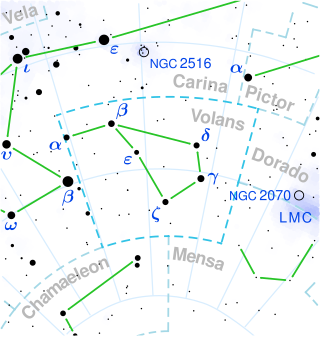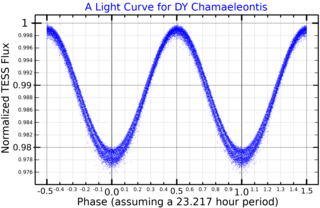Related Research Articles
HD 222399 is a double star in the northern constellation of Andromeda. The magnitude 6.57 primary is an F-type subgiant star with a stellar classification of F2IV. It has a magnitude 10.57 companion at an angular separation of 14.7″ along a position angle of 162°.
HD 92845 is a probable astrometric binary in the southern constellation Antlia. It has an apparent magnitude of 5.62, allowing it to be faintly seen with the naked eye. Parallax measurements place the system at a distance of 790 light years and it is currently receding with a heliocentric radial velocity of 4.5 km/s.
HD 152010 is a solitary star in the southern circumpolar constellation Apus. It has an apparent magnitude of 6.48, placing it near the max visibility for the naked eye. Located 1,006 light yearsaway, the object is approaching the Solar System with a heliocentric radial velocity of −15 km/s.

HD 24479, also designated as HR 1204, is a solitary, bluish-white hued star located in the northern circumpolar constellation Camelopardalis. The star is visible to the naked eye with an apparent visual magnitude of 5.04. Based on Gaia DR3 parallax measurements, it is located 385 light years from the Sun. However, it is receding with a somewhat constrained heliocentric radial velocity of 4.6 km/s. At its current distance, HD 24479's brightness is diminished by 0.29 magnitudes due to interstellar dust.

HD 93905 is a solitary star located in the southern constellation Antlia. The star has an absolute magnitude of 0 and an apparent magnitude of 5.61, making it faintly visible to the naked eye under ideal conditions. The star is located 371 light years away based on its parallax shift and is drifting closer with a helocentric radial velocity of −9.6 km/s.
HD 167257 is a solitary star in the southern constellation Telescopium. It has an apparent magnitude of 6.05, making it faintly visible to the naked eye. Parallax measurements place the star at a distance of 420 light years and has a radial velocity of −5.1 km/s, which is poorly constrained. This indicates that it is drifting towards the Solar System.
HD 64484 is a solitary star in the southern circumpolar constellation Volans. With an apparent magnitude of 5.76, it is faintly visible to the naked eye under dark skies. Parallax measurements place it at a distance of 458 light years but is receding with a heliocentric radial velocity of 11 km/s.

CD-73°375 is a binary star located in the constellation Volans about 820 light years away. The two components, HR 2979 and HR 2980, are separated by two arc-seconds. The pair has a combined apparent magnitude of 6.34. It has a radial velocity of about 13 km/s, which means it drifting away from the Solar System.
HD 33266 is a solitary star in the northern circumpolar constellation Camelopardalis. It has an apparent magnitude of 6.17, making it faintly visible to the naked eye. Located 481 light years away, it is approaching the Sun with a heliocentric radial velocity of −4.4 km/s.
HD 29559 is a solitary star in the southern constellation Caelum. It has an apparent magnitude of 6.40, placing it near the max naked eye visibility. The star is situated at a distance 408 light years based on parallax measurements but is receding with a heliocentric radial velocity of 24.2 km/s.
HD 63584 is a solitary star in the southern circumpolar constellation Volans. With an apparent magnitude of 6.15, it is barely visible to the naked eye under ideal conditions. The star is located 420 light years away based on parallax, but is drifting away with a radial velocity of 10.4 km/s.
HD 20104 is a visual binary in the northern circumpolar constellation Camelopardalis. The system has a combined apparent magnitude of 6.41, making it near naked eye visibility. When resolved in a large telescope, HD 20104 appears to be a pair of 7th magnitude A-type main-sequence stars with a separation of about 0.5″. Located approximately 550 light years away, the system is approaching the Sun with a heliocentric radial velocity of −6 km/s.
HD 35184 is a solitary star in the southern circumpolar constellation Mensa. It has an apparent magnitude of 6.50, which the maximum naked eye visibility. Located 375 light years away, it is receding with a heliocentric radial velocity of 13.6 km/s.
16 Delphini is a star in the equatorial constellation Delphinus. It has an apparent magnitude of 5.54, making it faintly visible to the naked eye. The star is relatively close at a distance of 198 light years but is receding with a poorly constrained radial velocity of 2 km/s.
13 Delphini is a binary star in the equatorial constellation Delphinus, with a combined apparent magnitude of 5.64. The system is located at a distance of 471 light years but is approaching the Solar System with a heliocentric radial velocity of about −7 km/s.
HD 193472 is a solitary star in the equatorial constellation Delphinus. It has an apparent magnitude of 5.94, making it visible with the naked eye if viewed under ideal conditions. Parallax measurements put it at a distance of 282 light years and has a radial velocity of −8 km/s, indicating that the object drifting towards the Solar System.
HD 75171, also known as HR 3495, is a solitary, white hued star located in the southern constellation of Volans. It has an apparent magnitude of 6.02, making it faintly visible to the naked eye under ideal conditions. The object is relatively close at a distance of 191 light years but is receding with a heliocentric radial velocity of 10.7 km/s. Eggen (1995) lists it as a probable member of the Hyades Supercluster.

HD 36187, also known as HR 1835, is a solitary, bluish-white hued star located in the southern constellation Columba, the dove. It has an apparent magnitude of 5.55, making it faintly visible to the naked eye under ideal conditions. Based on parallax measurements from the Gaia spacecraft, it is estimated to be 282 light years away from the Solar System. However, it is receding rapidly with a heliocentric radial velocity of 50 km/s. At its current distance, HD 36187's brightness is diminished by 0.21 magnitude due to interstellar dust.

HD 118285, also known as HR 5115, is a variable star located in the southern circumpolar constellation Chamaeleon. DY Chamaeleontis is its variable star designation. It has an average apparent magnitude of 6.32, placing it near the limit for naked eye visibility. The object is located relatively far at a distance of 864 light years based on Gaia DR3 parallax measurements but is receding with a heliocentric radial velocity of 18 km/s. At its current distance, HD 118285's brightness is diminished by 0.58 magnitudes due to interstellar dust.

HD 31134, also designated as HR 1561, is a solitary star located in the northern circumpolar constellation Camelopardalis, the giraffe. It is faintly visible to the naked eye as a white-hued star with an apparent magnitude of 5.74. Gaia DR3 parallax measurements place it 473 light years away. It appears to be approaching the Solar System with a heliocentric radial velocity of −15.1 km/s. At its current distance, HD 31134's brightness is diminished by 0.35 magnitudes due to interstellar dust. It has an absolute magnitude of +0.19.
References
- 1 2 3 4 5 Vallenari, A.; et al. (Gaia Collaboration) (2022). "Gaia Data Release 3. Summary of the content and survey properties". Astronomy & Astrophysics . arXiv: 2208.00211 . doi: 10.1051/0004-6361/202243940 . Gaia DR3 record for this source at VizieR.
- ↑ Høg, E.; Fabricius, C.; Makarov, V. V.; Urban, S.; Corbin, T.; Wycoff, G.; Bastian, U.; Schwekendiek, P.; Wicenec, A. (1 March 2000). "The Tycho-2 catalogue of the 2.5 million brightest stars". Astronomy and Astrophysics. 355: L27–L30. Bibcode:2000A&A...355L..27H. ISSN 0004-6361.
- ↑ Houk, N. (January 1982). Michigan Catalogue of Two-dimensional Spectral Types for the HD stars. Volume_3. Declinations -40_ƒ0 to -26_ƒ0. p. 390. Bibcode:1982mcts.book.....H.
- 1 2 Anderson, E.; Francis, Ch. (1 May 2012). "XHIP: An extended hipparcos compilation". Astronomy Letters. 38 (5): 331–346. arXiv: 1108.4971 . Bibcode:2012AstL...38..331A. doi:10.1134/S1063773712050015. ISSN 1063-7737. S2CID 119257644.
- ↑ Johnson, H. L.; Mitchell, R. I.; Iriarte, B.; Wisniewski, W. Z. (January 1966). "UBVRIJKL Photometry of the Bright Stars". Communications of the Lunar and Planetary Laboratory. 4: 99–110. Bibcode:1966CoLPL...4...99J.
- ↑ Kharchenko, N. V.; Scholz, R. -D.; Piskunov, A. E.; Röser, S.; Schilbach, E. (November 2007). "Astrophysical supplements to the ASCC-2.5: Ia. Radial velocities of ~55000 stars and mean radial velocities of 516 Galactic open clusters and associations". Astronomische Nachrichten. 328 (9): 889–896. arXiv: 0705.0878 . Bibcode:2007AN....328..889K. doi: 10.1002/asna.200710776 . ISSN 0004-6337. S2CID 119323941.
- 1 2 3 4 Zorec, J.; Royer, F. (1 January 2012). "Rotational velocities of A-type stars. IV. Evolution of rotational velocities". Astronomy and Astrophysics. 537: A120. arXiv: 1201.2052 . Bibcode:2012A&A...537A.120Z. doi:10.1051/0004-6361/201117691. ISSN 0004-6361. S2CID 55586789.
- ↑ Stassun, Keivan G.; et al. (1 September 2018). "The TESS Input Catalog and Candidate Target List". The Astronomical Journal. 156 (3): 102. arXiv: 1706.00495 . Bibcode:2018AJ....156..102S. doi:10.3847/1538-3881/aad050. ISSN 0004-6256. S2CID 73582386.
- 1 2 Anders, F.; et al. (1 August 2019). "Photo-astrometric distances, extinctions, and astrophysical parameters for Gaia DR2 stars brighter than G = 18". Astronomy and Astrophysics. 628: A94. arXiv: 1904.11302 . Bibcode:2019A&A...628A..94A. doi:10.1051/0004-6361/201935765. ISSN 0004-6361. S2CID 131780028.
- ↑ Royer, F.; Zorec, J.; Gómez, A. E. (1 February 2007). "Rotational velocities of A-type stars. III. Velocity distributions". Astronomy and Astrophysics. 463 (2): 671–682. arXiv: astro-ph/0610785 . Bibcode:2007A&A...463..671R. doi: 10.1051/0004-6361:20065224 . ISSN 0004-6361. S2CID 18475298.